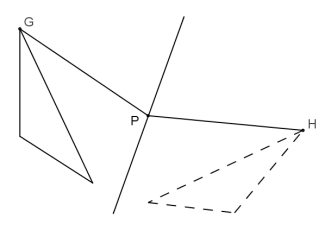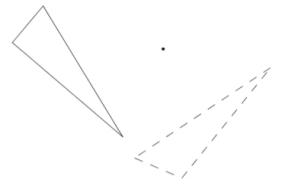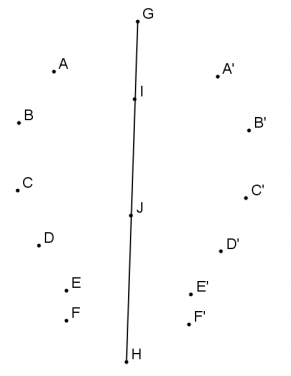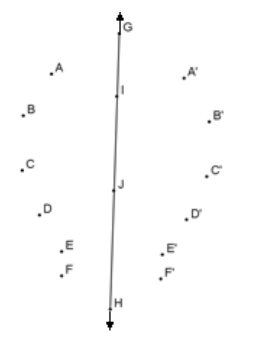Engage NY Eureka Math Geometry Module 1 Lesson 17 Answer Key
Eureka Math Geometry Module 1 Lesson 17 Example Answer Key
Example 1.
Is it possible to find or construct a line of reflection that is not a perpendicular bisector of a segment connecting a point on the pre-image to its image? Try to locate a line of reflection between the two figures to the right without constructing any perpendicular bisectors.

Answer:

Discussion
Why were your attempts impossible? Look back at the definition of reflection from Lesson 14.
For a line l in the plane, a reflection across l is the transformation rl of the plane defined as follows:
1. For any point P on the line l, rl(P)=P, and
2. For any point P not on l, rl(P) is the point Q so that l is the perpendicular bisector of the segment PQ.
The key lies in the use of the term perpendicular bisector. For a point P not on l, explain how to construct the point Q so that l is the perpendicular bisector of the segment PQ.
Now, let’s think about the problem from another perspective. We have determined that any point on the pre-image figure is the same distance from the line of reflection as its image. Therefore, the two points are equidistant from the point at which the line of reflection (perpendicular bisector) intersects the segment connecting the pre-image point to its image. What about other points on the perpendicular bisector? Are they also equidistant from the pre-image and image points? Let’s investigate.
Example 2.
Using the same figure from the previous investigation, but with the line of reflection, is it possible to conclude that any point on the perpendicular bisector is equidistant from any pair of pre-image and image points? For example, is GP=HP in the figure? The point P is clearly not on the segment connecting the pre-image point G to its image H. How can you be certain that GP=HP? If r is the reflection, then r(G)=H and r(P)=P. Since r preserves distances, GP=HP.

Answer:

Discussion
We have explored perpendicular bisectors as they relate to reflections and have determined that they are essential to reflections. Are perpendicular lines, specifically, perpendicular bisectors, essential to the other two types of rigid motions: rotations and translations? Translations involve constructing parallel lines (which can certainly be done by constructing perpendiculars but are not essential to constructing parallels). However, perpendicular bisectors play an important role in rotations. In Lesson 13, we found that the intersection of the perpendicular bisectors of two segments connecting pairs of pre-image to image points determined the center of rotation.
Example 3.
Find the center of rotation for the transformation below. How are perpendicular bisectors a major part of finding the center of rotation? Why are they essential?

Answer:
The center of rotation is the intersection of two perpendicular bisectors, each to a segment that joins a pair of corresponding points (between the figure and its image).
As you explore this figure, also note another feature of rotations. As with all rigid motions, rotations preserve distance. A transformation is said to be distance-preserving (or length-preserving) if the distance between the images of two points is always equal to the distance between the original two points. Which of the statements below is true of the distances in the figure? Justify your response.
1. AB=A’B’
2. AA’=BB’

Answer:
AB=A’B’ is a distance in the figure. The distance between A and B remains the same after the transformation. The second statement AA’=BB’ is incorrect because it involves distances between the original figure and the new figures. Rotations are distance-preserving; thus, we are only assured that distance between the images of two points is always equal to the distances between the original two points.
Eureka Math Geometry Module 1 Lesson 17 Exercise Answer Key
Opening Exercise
In Lesson 3, you bisected angles, including straight angles. You related the bisection of straight angles in Lesson 3 to the construction of perpendicular bisectors in Lesson 4. Review the process of constructing a perpendicular bisector with the segment below. Then complete the definition of perpendicular lines below your construction.

Use the compass and straightedge construction from Lesson 4.
Two lines are perpendicular if they __, and if any of the angles formed by the intersection of the lines is a ___ angle. Two segments are perpendicular if the lines containing them are ___.
Answer:
Two lines are perpendicular if they intersect, and if any of the angles formed by the intersection of the lines is a right (or 90°) angle. Two segments are perpendicular if the lines containing them are perpendicular.
Ask students to discuss the definition of a perpendicular bisector and how having already learned the construction helps them to know and understand the definition.
Discussion
The line you constructed in the Opening Exercise is called the perpendicular bisector of the segment. As you learned in Lesson 14, the perpendicular bisector is also known as the line of reflection of the segment. With a line of reflection, any point on one side of the line (pre-image) is the same distance from the line as its image on the opposite side of the line.
Exercises
In each pre-image/image combination below, (a) identify the type of transformation; (b) state whether perpendicular bisectors play a role in constructing the transformation and, if so, what role; and (c) cite an illustration of the distance-preserving characteristic of the transformation (e.g., identify two congruent segments from the pre-image to the image). For the last requirement, you have to label vertices on the pre-image and image.
Exercise 1.

Answer:

Exercise 2.

Answer:

Exercise 3.

Answer:

Exercise 4.

Answer:

Exercise 5.
In the figure to the right, \(\overleftrightarrow{\boldsymbol{G H}}\) is a segment of reflection. State and justify two conclusions about distances in this figure. At least one of your statements should refer to perpendicular bisectors.

Answer:

Each point and its reflected image are the same distance from the line of reflection.
The line of reflection is the perpendicular bisector of the line connecting each point with its reflected image.
Eureka Math Geometry Module 1 Lesson 17 Problem Set Answer Key
Create/construct two problems involving transformations—one reflection and one rotation—that require the use of perpendicular bisectors. Your reflection problem may require locating the line of reflection or using the line of reflection to construct the image. Your rotation problem should require location of the point of rotation. (Why should your rotation problem not require construction of the rotated image?) Create the problems on one page, and construct the solutions on another. Another student will be solving your problems in the next class period.
Answer:
Answers will vary.
Eureka Math Geometry Module 1 Lesson 17 Exit Ticket Answer Key
Using your understanding of rigid motions, explain why any point on the perpendicular bisector is equidistant from any pair of pre-image and image points. Use your construction tools to create a figure that supports your explanation.
Answer:
If r is the reflection, then r(G)=H and r(P)=P. Since r preserves distances, GP=HP.
